Crowd at Komrads. Photo courtesy of Shawn Riker.
Article originally published June 21, 2012 by The Grid online (TheGridTO.com).
In this edition of her nightlife-history series, Denise Benson takes us back to the after-hours nightclub that helped mobilize Toronto’s gay-rights movement in the 1980s.
BY: DENISE BENSON
Club: Komrads, 1 Isabella St.
Years in operation: 1985-1991
History: In 1980s’ Toronto, street corners and dance clubs still served as essential meeting spots for gays and other marginalized communities. The stretch of Isabella closest to Yonge called out to many, especially after dark.
On the outer edges of the Church and Wellesley-centred gay village, the corner was close to popular homo haunts including Yonge Street’s St. Charles Tavern, Trax, and the Parkside Tavern, with gay dance club Stages above it. Nearby bathhouses were plentiful, Queen’s Park was still a major pick-up spot, and easy bar-hopping meant that gay men had lots of options even in those pre-Grindr days.
“The Yonge and Isabella area was really amazingly gay,” recalls event producer Maxwell Blandford, once a key figure in adventuresome Toronto clubs and now based in Miami. “Many bars, along with stores like Northbound Leather, were within a couple of blocks and infused thousands of gay people into that corridor.
“There were loads of transsexuals, rent boys and other sex workers, cross-dressers, goth kids, punk-rockers, and glam-rockers hanging out around House of Lords. There was loads of cruising all over that area. You could find anything anywhere and at any time.”
The upper level at 1 Isabella was a known hub. In the 1970s, it had housed discos including Mrs. Nights and Cheetah Club. Come the early ’80s, it was the original home of influential alternative spot Domino Klub. That club gave way to notoriously tough gay-and-straight dance club Oz, which boasted entrance hallways designed to look like yellow brick roads.
Alain Plamondon, who would become one of Toronto’s most beloved gay DJs, was a busboy at Oz. He tells the story of 1 Isabella’s transition into Komrads, a club he helped build and would go on to work at as busboy, server, bartender, lighting man, and, eventually, DJ.
“Basil Mangano was the owner of the space at 1 Isabella,” Plamondon begins in an email. “He hired John Burt to be a manager near the end of Oz’s existence. John was well-known in the community, and extremely active in gay politics. He convinced Basil to close down Oz to build a club that would bring class to the gay community.
“Komrads, with its shiny, stainless-steel dancefloor, hi-tech sound and lighting—including pink and purple neon lights—was a hit, and the talk of Toronto’s gay community when it opened in August of 1985.”
Why it was important: Open seven nights a week, with a café serving food from the afternoon onwards, Komrads was a safe and well-maintained club that cared about its gay clientele. The club boasted not only state-of-the-art sound, but also the largest dancefloor of any Toronto gay club at the time.
“John Burt was good at attracting crowds,” says George Fichna, one of Komrads’ longest-serving weekend doormen; he had also worked for landmark local gay bars Club Manatee and St. Charles’ Maygay room.
“John kept the place looking nice, with new carpets, paint, marble countertops on the bars, overhead TVs in the dining room, and so on.”
Partly as a result, Komrads often entertained crowds of 500 to 1,000 people, many of them spilling in from other bars after the 1 a.m. last call.
“For a while, Komrads was the only permanent after-hours club around,” Fichna explains. “In the early days, the bar closed at 1 a.m. and then served coffee, water, or soft drinks. Later, they served under the table.”
Whatever time the crowds arrived, Komrads was a key gathering spot for a community that had grown increasingly organized and politicized. The 1981 Toronto gay bathhouse raids marked a turning point in the community’s fight back against police harassment and other forms of discrimination.
A gay and lesbian liberation movement swelled as queers across this country fought against censorship, worked to win key human rights (we were awarded provincial protection in 1986 when “sexual orientation” was added to the Ontario Human Rights Code as a prohibited ground for discrimination, with the federal equivalent granted only in 1996), and mobilized against the onslaught of HIV/AIDS as it took the lives of far too many friends, lovers, and talented people.
“We were fighting for our rights in the ’80s, and Komrads was the place to go to celebrate our political ‘wins,’ with John Burt at the helm,” Plamondon says. “We chose to celebrate life, and had a ‘We’re not going to take crap from anyone’ attitude. We celebrated and we had a political voice at Komrads.”
At the time, gay and lesbian bars were an intrinsic part of our liberation movement. The dancefloor served as rallying point as much as it did a place to party. For a number of years, Komrads set the pace with its size and unequivocally gay programming.
In the 1980s, the music in gay bars was notably different than most straight dance spots. Whether playing disco, hi-NRG, new wave, underground house, or more commercial house, gay DJs leaned towards remixes, re-edits, and 12-inch extended versions of songs.
Good DJs break new ground, and Komrads’ star resident, Greg Howlett, was one of this city’s best. (Visit the Then & Now Mixcloud page to hear a number of live mixes by Howlett recorded at other venues.)
“Three or four months after Komrads opened, John hired Greg Howlett,” recalls Plamondon. “With Greg at the turntables, Komrads’ success was sealed. Greg played the best that dance music had to offer. He was brilliant.”
Dundas, Ontario native Howlett had played in clubs both straight and gay, including Le Tube, Mrs. Knights and Stages, and came to Komrads as an already-established trendsetter.
“Greg was a risk-taker, and often the first DJ to play songs,” recalls Vince Degiorgio, a good friend of Howlett’s who had DJed alongside him and is now involved in music publishing.
“Because of Greg, there’d be this stampede to stores like Starsound, J’s, and Disco Sound to get what he was playing. Numerous DJs would sit with notebooks, writing down what he played in order to copy what he was doing.
“Greg’s mixing was positively sublime and built a rush. He was a legitimate rock star long before DJs were allowed to be. And he was unique—not in a two-hour residency gig, but in a four-nights-a-week, never-let-you-go, I’m-gonna-peak-your-brains-out style.”
Howlett packed Komrads’ dancefloor during its first few years, but then left the club to work next door at equally popular gay bar Chaps (9 Isabella St., now a Rabba). Howlett played at Chaps until late into his fight against HIV/AIDS. He passed away in 1992, and is reported to have left Komrads in response to internal management struggles.
Plamondon tells me that John Burt resigned as manager after three years at Komrads.
“John, it was his baby, but politics came into play, and Basil and him parted ways in business. John left in the middle of Komrads’ success, and his leaving changed everything.” (Burt chose not to respond to questions about Komrads while Mangano could not be reached for comment.)
Following Howlett, a number of DJs stepped up to Komrads’ turntables at a time when competition was stiff—not only with Chaps next door, but also Club Colby’s at 5 St. Joseph St. and Boots & Buds at 592 Sherbourne.
Lighting man and Starsound Records’ employee Gerry Nault became the key Komrads resident until he too became too sick to DJ. After him, DJs including Carlos C, Kevin Laforme, and Allan Young played for years, but Komrads was equally popular for its live performances.
“Komrads was a dance club, yes, but it was always meant to showcase dance artists and female impersonators as well,” explains Plamondon.
“Divine was featured twice, and was a huge cult hit both times. Many more would perform, like Sylvester, Thelma Houston, Loleatta Holloway, Bronski Beat, and Jennifer Holliday, from the original cast of Dreamgirls.
“Our most successful concert event was by Village People. Unlike the other acts, Village People were promoted on MuchMusic, and much to everyone’s surprise, 80 per cent of the crowd was straight. We gave local talent the spotlight as well; I have great memories of watching Eria Fachin perform her huge hit anthem “Savin’ Myself.””
Komrads also featured some of this city’s greatest female impersonators, including Craig Russell, star of the film Outrageous!, and members of legendary drag troupe The Great Imposters such as Randy Cole, who frequently performed as Tina Turner.
Years later, professional female impersonator Stephanie Stephens, now known for her troupe The Imposters and for her own take on Tina Turner, would perform Thursday and Saturday late nights at Komrads. The show, named Hot Spot, also featured performers including Dale Barnett (The Great Imposters), Jackae Baker, and Komrads’ doorman Tony Brown, who appeared on stage as Toni.
“I will always remember Toni Brown,” says Stephens. “She was the head doorman and wore short spandex pants, and a weightlifting belt around her tiny waist. Toni was eight feet tall, with a James Brown perm. We were friends, and she used to make me laugh, asking people for ID or asking a drunken queen to leave the club, calling them ‘Mary.’
“We had the only late-night show and after-hours crowd, and the place was packed,” Stephens tells me. “It was the spot for drag shows and good DJs. Komrads was lively and welcoming, with little attitude. There was a real sense of community; people seemed to care about what was happening around them.”
With its gender inclusive door policy—Komrads was one of the only gay men’s clubs of the time that welcomed women, both gay and straight—late nights, and capacity crowds, the club attracted audiences who mixed more comfortably some evenings than others.
Doorman Fichna recounts a favourite memory.
“I remember a night when a group of girls came in with some straight young men, and we had to remind them that they were in a predominately gay place so if they got a pinch or a grope, they should let it pass. If they started a fight, they’d get thrown out.
“Two of the guys went to the washroom, and then behind them a transsexual. I had a feeling so I stood in the can and watched. The two young men were apart with a urinal in between them, and the [trans woman] stood in front of it, hiked up her dress, and proceeded to urinate. The two boys finished up quick, and got the hell out of there. When she came out I asked, ‘You just couldn’t just use the toilet stall like a lady, could you?’ She replied, ‘It was more fun that way.’ I agreed.”
Who else played/worked there: Bars often rise or fall based on the word-of-mouth created by their staff. Komrads employed dozens of popular young men, with bar staff including Todd Gibbons, Tom Paradis, Bradford Paolini, and Roger Reynolds mentioned frequently, along with doorman Omar and a beloved manager named Beatrice.
Popular gay producer/DJ Shawn Riker was a key Komrads employee—maintaining the sound, doing lights, acting as a manager and more—long before he would co-found current gay hotspot FLY Nightclub.
Some of today’s best-known local gay DJs—including Plamondon, Mark Falco, and Cory Activate—DJed at Komrads during its final years.
DJ Scott Cairns became Komrads’ Saturday late-night resident at the close of the 1980s, and recalls playing a mix of underground and crossover house along with more commercial sounds.
“When I first started there, Komrads was basically just another gay dance club, except it stayed open late,” says Cairns. “Because of this, it cleaned up.”
By 1990, however, this was no longer the case. Komrads had lost much of its crowd. Gay men had flocked to after-hours dance clubs like Twilight Zone, and went on to frequent weekly events hosted at mixed clubs like The Diamond, Boom Boom Room, and Tazmanian Ballroom.
Komrads’ owner Basil Mangano approached innovative promoter Maxwell Blandford, who’d been the force behind Tazmanian Ballroom’s successful Rock & Roll Fag Bar weekly, in 1990.
“Basil asked me to take Komrads over and try to revive the venue,” says Blandford.
He agreed on the condition that Mangano would renovate and allow Blandford to reinvent the space. Blandford created a club-within-a-club as he developed a front-room pub dubbed The Amazon Queen.
“We bought the inside of a 1940s gentleman’s club that I found in the Beaches, and installed it,” he says. “We opened with a Madonna Truth or Dare premiere party benefiting the Toronto PWA Foundation, and hosted a voguing ball with Willi Ninja.”
The Amazon Queen also featured Vancouver singer Naomi McLeod (who’d sung with Sarah McLachlan and Skinny Puppy) performing under the persona of Dolly Kelekatrone, and a selection of tunes that ranged “from Nina Simone to Jimi Hendrix.”
Blandford also hired DJs including Cairns, Falco, and Mark Oliver to play “socially relevant house music” in the club’s main dance club area.
“By the time of Amazon Queen, all bets were off,” Cairns recalls. “There was a new attitude and all that high-energy cha-cha music was pretty much abandoned.
“We all bonded over Warp Records, and the label’s output of records like LFO, Tricky Disco, and Sweet Exorcist’s ‘Testone,’” adds Cairns, who would later make his name at clubs including Chaps, The Phoenix and JOY.
“This UK bleep techno, along with deeper house sounds, were finally breaking into the more mainstream clubs. Amazon Queen and Max brought in a cooler crowd, although that period was more sparse than in the club’s heyday.”
Parties with titles like Fruit Machine and Electric Ass may have brought in trendier gays and celebrities including Boy George, Deee-Lite, George Michael, Depeche Mode, and Adeva, but Blandford couldn’t revive a done deal.
“Our biggest attraction was probably that we served liquor after-hours like a booze can, and never seemed to have any issues,” Blandford admits. “I was told that the reason we were able to remain open was because there was a serial killer targeting gay people on the loose, and the police believed that he was hanging out in Komrads so, by allowing us to stay open, they were able to get better leads. There were always loads of cops in Komrads after hours, and we were never shut down or given a ticket so the story made sense.”
What happened to it: According to Plamondon, Komrads closed in the spring of 1991.
“Komrads closed when Basil sold to the people from Colby’s,” adds Blandford; “Basil gave no notice whatsoever. We just showed up one day and the doors were locked.”
By summer, 1 Isabella St. had re-opened as Bar 1.
“I was fired and later rehired,” recalls doorman Fichna. “When I came back, it was Bar 1, and Basil had his fingers in it again.”
Some of Komrads’ later DJs, including Falco, Cory Activate, and Plamondon—now at The Barn and DJ of the 13-year-strong Retro Drama Sundays at Zipperz/Cellblock—also played at Bar 1. It closed in 1995.
1 Isabella would later host clubs with names like Generations, Radius, and Spincatz, but will long be remembered as Komrads.
“I think Komrads employed a lot of flamboyant gay people who would have had a tough time being themselves working in other venues,” summarizes Blandford. “The volume of clientele that Komrads and the other clubs produced allowed gays to have a serious physical presence, and empowered gay people to rally against homophobia and create community spirit though those dark times.
“Komrads was the anchor of that corner and, as it died, sadly much of the gay presence at that corner ended.”
Today, the site is home of Yonge Street Fitness. [Addendum: Yonge Street Fitness closed doors in December 2013. The space remains vacant.]
Thank you to all who participated, with a special nod to the very helpful Alain Plamondon. Thanks also to Shawn Riker, John Wulff, Gregory Plytas, Allan Tam, Andrew Boyd and the members of Facebook group Komrads Nightclub Survivors.
Late gay activist Rick Bébout provided invaluable history through his important online memoirs, Promiscuous Affections: A Life in the Bar, 1969-2000.

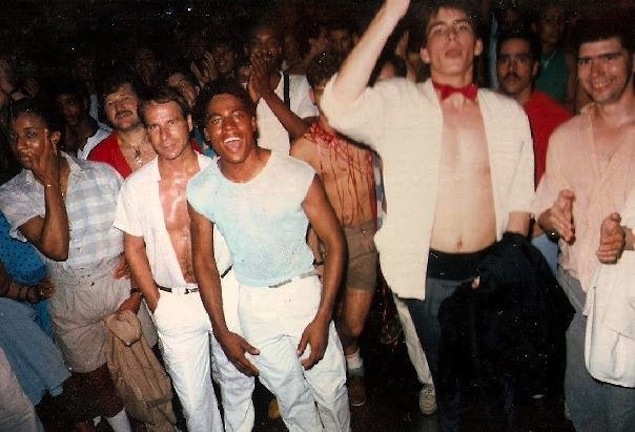
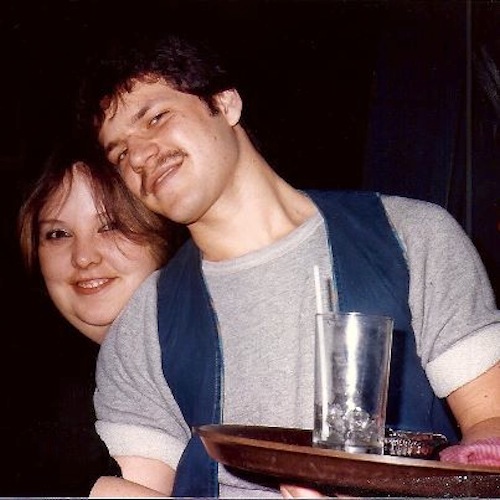
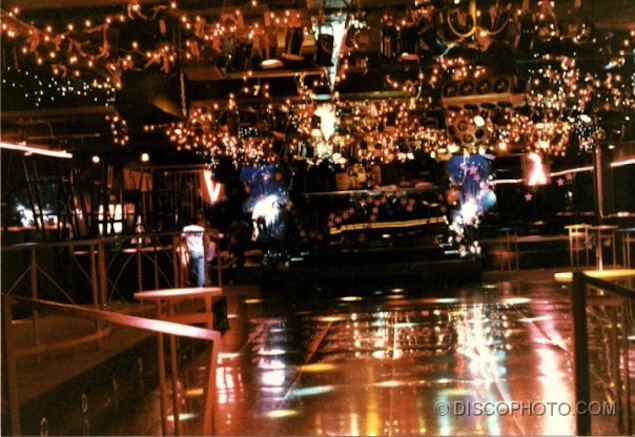
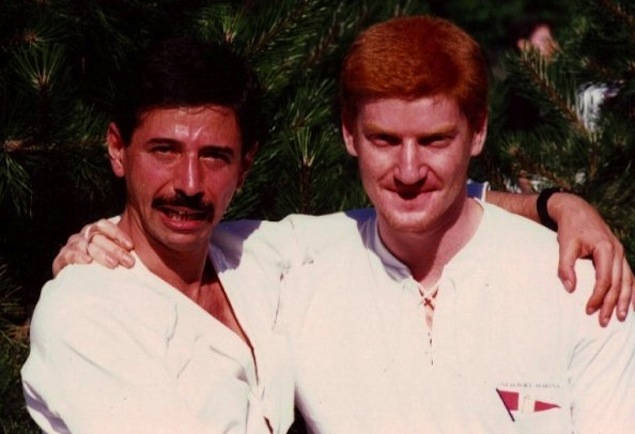
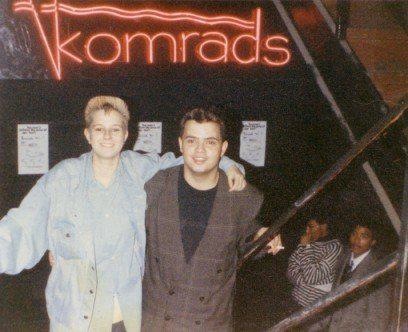
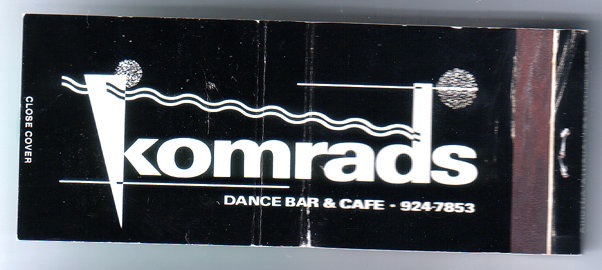
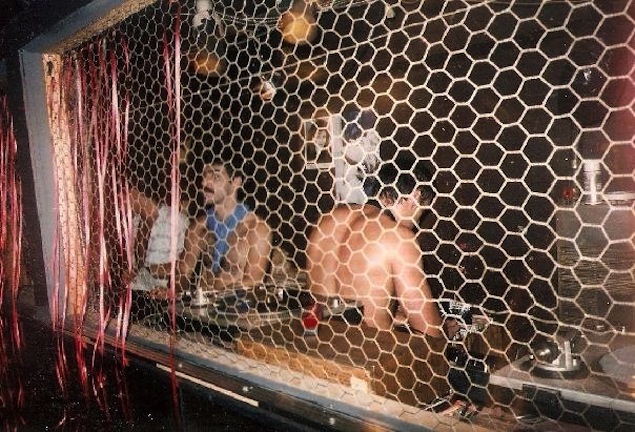
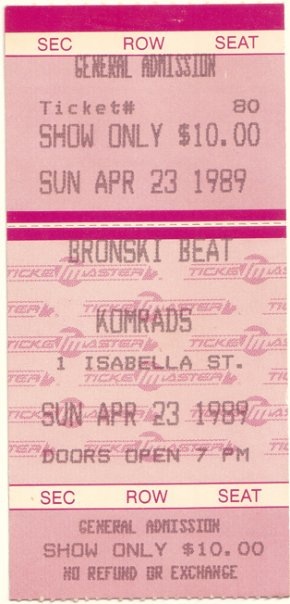
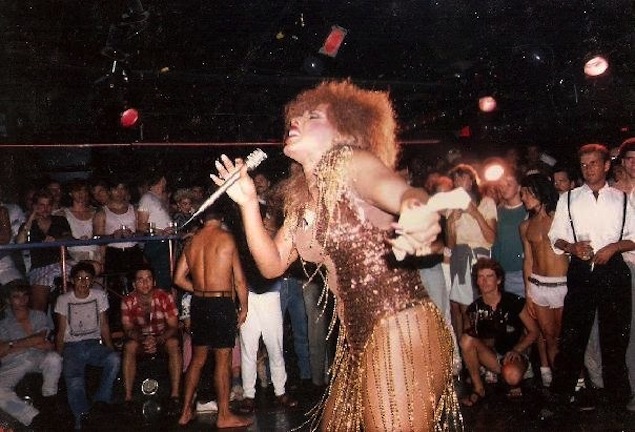
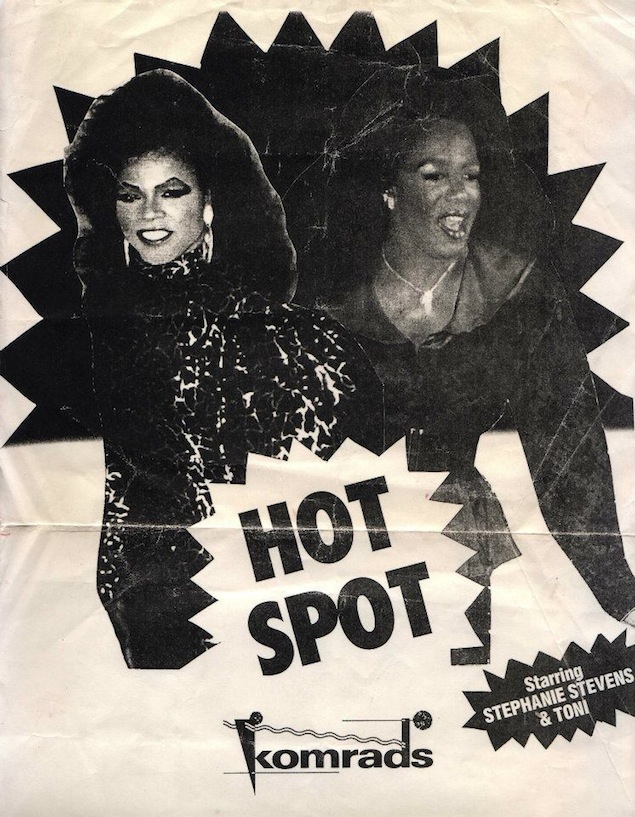


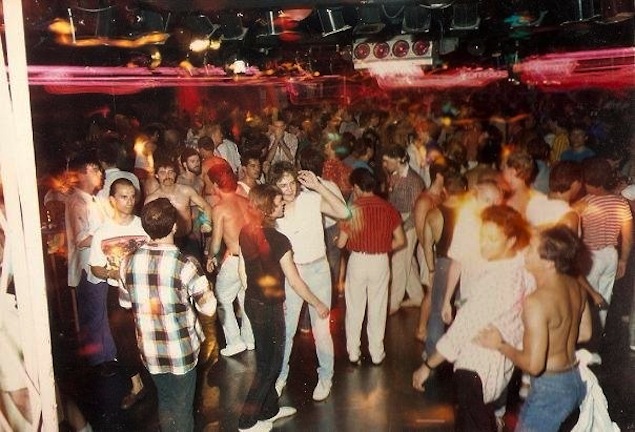
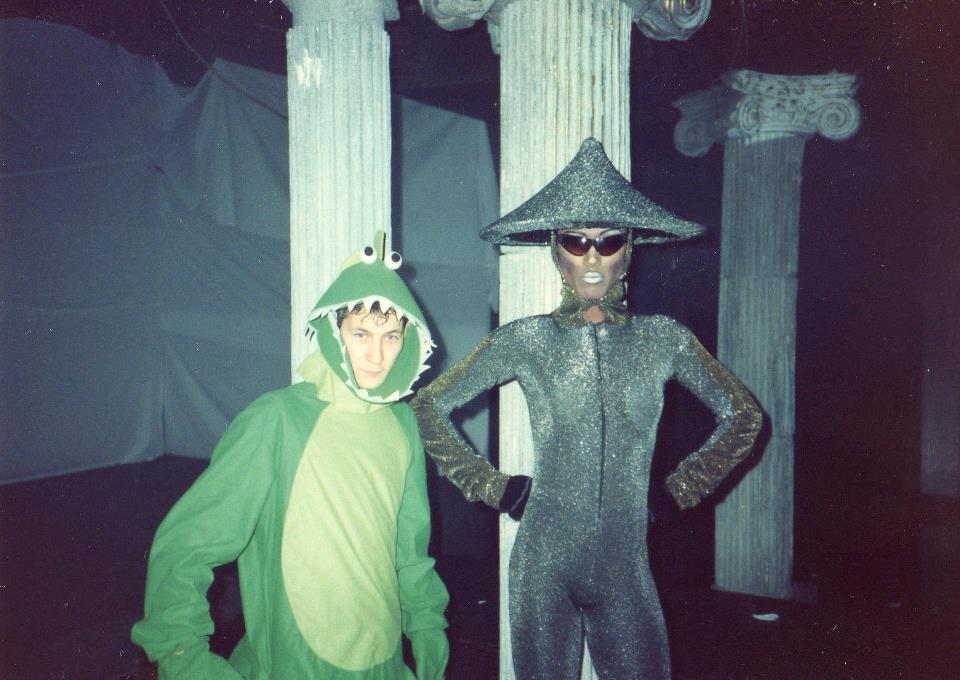
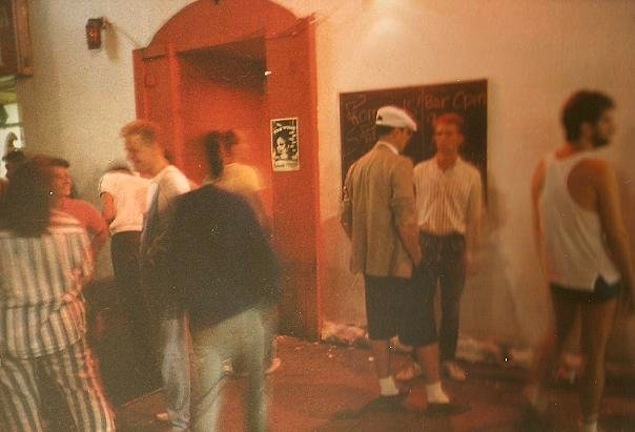
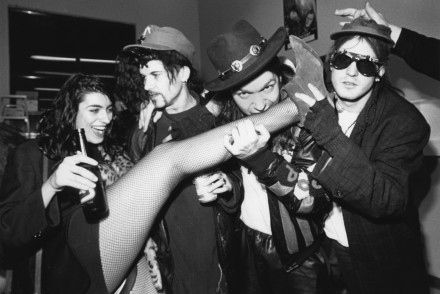
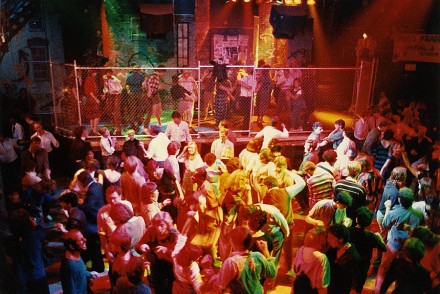
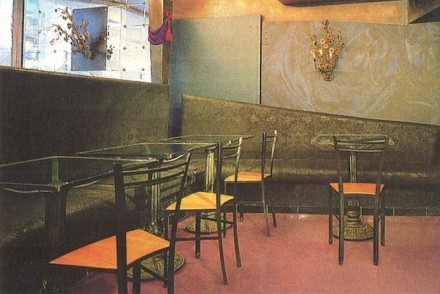

6 Comments
Just came across this article, have so many great memories of Komrads ,Chaps ,The Barn ,Trax ,Boots and Buds remember Tony the doorman he was a great guy. I became friends with Victor who later bartended at Woodys .
Back then I worked at the Barracks at 56 Widmer that was definitely a place off the beaten path .
Pre Internet before Grindr etc.. People actually had to go out to meet friends etc… Unfortunately we now live in
world where people think texting and gay apps are meeting people. Call me old I still believe meeting someone is something done face to face. Nothing beats looking someone in the eye and having a conversation.
Great fun always! I was there every weekend! The young lady in the picture with Alain P. was named Beverly. She was a real regular and loved getting friendly with all us young gay guys…
My sister worked there in the lat 80s. I wish I could find photos of her.
[…] the nightclub that had moved in to 1 Isabella post-Domino. (The address would later house gay club Komrads.) In 1985, Darlene Weswaldi hired Palmer to play at Klub Domino where he would spin a mix of rock, […]
I was one of the promoters for BAR ONE, for such a long time i forgot a lot ……but we did nail down Thursday nights with OUT magazines Shawn Vanassa at the Door , yes there was Basil and Judy and then there was Vigil and Richard of F/X at the door lol ! WE WERE CRAZY but we were the only place to go in the area late nights, some of my best memories of my youth were scattered upon that dance floor, we spent hours in front of those mirrors ! LOL ! Those were the days and daze when a laser beam and a big dry ice machine blew your mind all the time and the party party party FEE WAS LITERALLY FREE if you were on the v.i.p. list. BUT even back then the door price for entry was only 5 bucks ! NOT many bars or clubs today can handle that now huh ! I fbrought U2 there to party and also Madonna and some others to many to name or recall ! WE were all there, micheal holztman, dino and terry on and on and on ! lol !
All comments in the string below have been republished from their original appearance on The Grid website. We’re including the readers’ comments as they add to these Then & Now stories. We look forward to reading new comments here as well.
Sashine
Thanks for posting this … so good to read about Komrad’s again. And now, the space is no longer Yonge Street Fitness. They closed on Dec. 1, 2013 (non-payment of rent). Who knows what will become of the space? Komrad’s was “the” place to be, with its large dance floor and big bar. I can’t recall, though if it was Komrad’s when the shootings took place, or if it had been under another name at the time. I do recall hearing the shots, though, around 4.00am. early on a summer weekend. Seems to me it wasn’t too long after that they closed the doors as a club and it eventually was re-developed as the gym space. 9:01 pm on December 23, 2013
john
Oh my god …. I cried when i read all this !!!! All those great friends and fantastic time in life.here really was a sense of taking care of each other . My favourite .. Micheal Shoot . Remember the day his wig flew across the room when someone threw it up in the air . It got caught in the ceiling fan . what drama ! some of my favourite memories as i came out out out !. Oh how i miss those days . Thank you for this site john k 8:26 pm on September 16, 2013
Reog
I worked at Komrad’s for 2 years and managed the Coffee Cafe downstairs for 4. It may have earned itself a bad reputation, but the I’ve never seen as much love and support among a business’ clientele. Thanks for some great memories! B 10:04 pm on August 27, 2013
Brandon Stone
Just imagine the kind of party you could have with marble countertops from Vancouver or something, only use the material on the floor. Man, you could dance, breakdance, and so much more.  12:02 pm on June 19, 2013
Daniel Paquette
Komrades was fantastic but one thing missing from this is that hundreds of us use to hang out on the street in front of the club just like we use to a block south in front of voodoo and various other clubs. it was such an amazing street party and nothing like it has happened since. 9:19 pm on June 27, 2012
TOfag
What a great article Denise. It really brought back a flood of great memories of (dare I say it) ‘the good old days’. I too spent many late nights on Komrads stainless steel dance floor, enjoying the best dance music in the city. That area really was a hub for gay nightliffe at the time, too bad we have such a meager selection of places to go to now…sigh… 2:29 pm on June 27, 2012
JoeyDavid.com
The first gay club I went to was Colby’s in the 90′s. I was only 18 yrs old back then and I thought it was terrifying going to a gay club. But I then loved the club and I was a frequent clubber back then dancing crazy without the need of substances/alcohol. Those were the days. When Colby’s closed down, it was sad because it was a good club with awesome music. And the other club compared to that was ‘Boots’ on Parliament which closed down when the hotel bought the building. 11:41 am on June 27, 2012
wildeyed
The best – bar none! 9:59 am on June 27, 2012
sammi
Denise – you write like you spin, cool, generous, smart. Back in 1986, I was a small town boy new to the city, newly out – Komrads was my first home. Had my first date there (o, so bad); met my first friends; fell in love for the first time; and of course, danced, like a fool, like a fiend, all night, ’til they kicked me out. Just being around so many gay men, and so many different types of gay men, was liberating. Never felt so accepted, never felt so cool – even if it was only by association. 9:46 am on June 27, 2012
ggn
fantastic research and writing. thx. 9:22 am on June 27, 2012
manliano
Give me a place like this over Grindr anytime. Love knowing this at least existed in my city, even if I was too young to partake. 12:37 pm on June 24, 2012
Dj Cory Activate
What a fabulous article!! MANY thanks to Denise, Alain and everybody who contributed to it. I owe my career to Komrads and Dj Gerry Nault. As a young gay guy from Whitby, Ontario, I can’t even begin to tell you how important 1 Isabella was to me. After coming out and going to LGYT (Lesbian and Gay Youth Toronto – at the 519) in 1986, Komrads was the first contact I ever had with big, mainstream gay culture. It changed me (and MANY other people I knew!) forever. As a young suburban gay male in the 80′s, it’s impossible to underestimate the impact that gay bars and clubs of that era had – for MANY of us, they were our lifeline. Komrads was the first place that I, as a young music lover, would ever hear “beat mixing”. I was blown away!! How were these DJ’s changing vocals on tracks while the beat kept going?! I was enthralled! The DJ was Gerry Nault, one of Komrads residents on Saturdays, and I was HOOKED. I would sit there for hours on end (literally!) watching him do what he did so masterfully! He would regularly “SHOO!” me from the front of the booth, tired of my endless “WOW” face and inevitable questions!! lol! I would go, but I’d be back the next week!! From those first, early moments, there was no question in my mind what I wanted to do! The impact of Komrads and those pioneering DJ’s (Gerry Nault, Greg Howlett, Peter Frost, Alberto Zara, Allan Young, Kevin LaForme, etc) is incalculable for me. I owe them everything  Anyway, again, thanks to Denise Benson! It’s a wonderful thing that we’re keeping our shared nightlife history alive! All of us in the nightclub industry owe you a debt! In the age of “now! now! now!”, it’s nice to look back to “then!”. ~DJ Cory Activate 3:52 am on June 22, 2012
sammi
Dj Cory Activate – Got to thank you for some great times. Your music nearly killed me. I mean that. Got so intense sometimes I felt like I just might die. 9:48 am on June 27, 2012
Roger
“PLAY MY SONG FOR ME!” love ya, Cory! Roger (famous for shouting out for ‘GLORIA!”) both at the Barn and Zippers/Cellblock. Hope to drop by this weekend for PRIDE! *kisses* 11:38 am on June 27, 2012